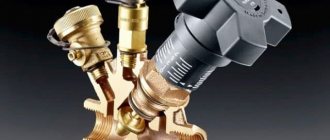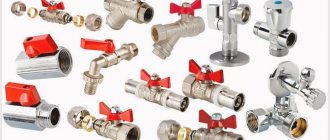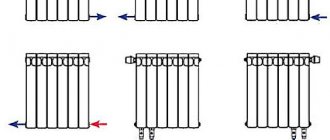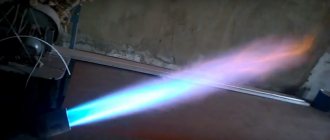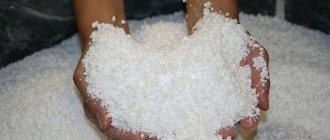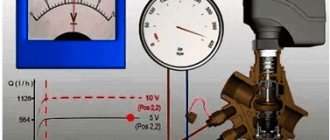Shut-off valves for pipelines are designed to regulate the flow of liquid moving through a pipe - turn it off, start it up and redirect it. We will understand the features of these parts, the specifics of their operation within the pipeline system, the classification and differences between one group of devices and another, and also study the main properties, selection parameters and operating rules during installation work.
Shut-off valves are an important component of the water supply system Source sgrupp.ru
Application of shut-off valves
Elements of shut-off valves are used in engineering systems for general technical purposes and for work in special conditions. Installation on pipelines with the following types of working media is allowed:
- water;
- ferry;
- gases;
- oil and petroleum products;
- chemicals, including aggressive ones (special version).
The main areas of application are housing and communal services enterprises, energy systems, chemical, food industries, agriculture, mining, metallurgy, and other structures.
The following materials are used in the production of shut-off valves:
- carbon and corrosion-resistant steels;
- cast iron;
- titanium;
- non-ferrous alloys (brass, bronze).
Valves
Products of this type are used on production lines and in transport pipelines for industrial purposes. The valve is manufactured in the following versions:
- with manual control;
- with electric drive in standard and explosive versions;
- with hydraulic drive.
On large-diameter shut-off valves with manual control, a gearbox with a worm, bevel or cylindrical gear is installed to reduce the force on the flywheel. If the valve spindle is located horizontally, the electric drive is mounted on a support, the worm and roller bearing are thickly lubricated with oil.
Main characteristics:
- conditional pressure, P, MPa (kgf/sq. cm): 0.16 (1.6) – 25.0 (250);
- nominal diameter, D, mm: 50–2000;
- working environment temperature, K (°C): +213 (-60) − +838 (+565).
Pressure regulator
The operation of the batteries and the pump is disrupted due to high or low pressure levels. Correct control of the heating system will help to avoid this negative factor. The pressure in the system plays a significant role, it ensures that water gets into the pipes and radiators. Heat loss will be reduced if the pressure is standard and maintained. This is where water pressure regulators come to the rescue. Their mission is primarily to protect the system from too much pressure . The operating principle of this device is based on the fact that the heating system valve located in the regulator works as a force equalizer. Depending on the type of pressure, regulators are classified into: statistical, dynamic. It is necessary to select a pressure regulator based on throughput. This is the ability to pass the required volume of coolant, in the presence of the required constant pressure drop.
Valves classification
Based on the design of the shut-off valve spindle, valves are distinguished:
- with a non-retractable (rotating) spindle. When opening and closing, the element performs only rotational movements, the thread is in contact with the working flow;
- with retractable spindle. The locking element moves translationally, the nut and running threads are removed from the valve cavity.
According to the shutter design:
- wedge valves. The O-rings in the design are located at an angle. The fittings can have a solid elastic or rigid wedge or a double-disk composite locking element;
- parallel gate valves (gate valves). The O-rings are located parallel to each other. The locking device can be made in the form of a sheet or a disk, or in the form of two disks with a spacer wedge or a spring. Parallel valves are most often cast from cast iron and are used in gas and water transport systems. Models with a retractable spindle are mounted on pipes with a diameter of at least 50 mm.
Briefly about the main thing
The pipeline has long come into use, becoming a basic part of the life of all people. One of the parts that is of key importance in pipeline structures is shut-off valves. The device is a kind of regulator with movable valves. Being inside the pipeline, they direct, stop, and mix the liquid or gas passing through it.
Shut-off valves for pipelines are divided into many types and types. Such a multifaceted classification is due to a wide range of body materials, connection methods, shape, etc. Also, the operating conditions for which the part is intended play a big role here.
When choosing a device, it is important to pay attention to the type of pipeline and the parameters of the part itself. They must correspond with each other. It should be remembered that the most important condition for the functioning of this part is tightness. And for this you need a flat surface (if you install the device into a pipe with defects, the tightness will be broken).
Each device has its own specifics and is characterized by certain features. To install/dismantle and repair such devices, you must have certain knowledge, abilities and acquired skills. Therefore, it is not recommended to do such repair work yourself.
Valves
A valve is a device in which the movement of the locking element is carried out by means of a running nut and a spindle (threaded pair). The valve has the property of self-braking, so the shut-off element can be left in any intermediate position.
Main characteristics of valves:
- material of the main parts - gray cast iron of grade no lower than SCh18–36;
- nominal diameter, D (mm): 15, 20, 25, 32, 40, 50, 65, 80, 100, 125, 150, 200;
- type of connection to the pipeline: flange or coupling;
- valve seal material: fluoroplastic-4, acid-alkali-resistant rubber of medium hardness;
- working medium: steam, water;
- maximum temperature in the pipeline, K (°C) - 489 (225).
Valve classification
According to the housing design:
- checkpoints. Valves of this type are mounted on straight sections of the pipeline, where a decrease in the flow of the working medium is not allowed. Pass-through fittings have a lot of weight and high hydraulic resistance;
- direct flow The pipes of such a shut-off valve are located opposite to each other. The body is more compact, but long and heavy. Hydraulic resistance is lower than that of straight-through models;
- three-way mixing. Such shut-off valves may have three or four connecting pipes. The devices are used to connect several streams with different working media: gaseous and liquid. Mixing valves are used to stabilize the operating temperature, the liquefaction process, dosing of reagents, etc.;
- corner. Shut-off valves of this type have perpendicularly located connecting pipes and are mounted in places where the main turns.
By type of control element:
- single saddles. The valve is made in the form of a needle with a cross-section of variable length. The locking element can be attached to the spindle or be integral with it. The valve is mounted in the body via a thread, but does not provide a tight seal when closed. The valve is suitable for operation in systems with low gas flow;
- two-saddle. Such valves unload the stem along the axis when there is a difference in pressure at the inlet and outlet. Weak lifting of the control element does not provide sufficient locking tightness.
According to the degree of sealing:
- stuffing box They have a simple design and low cost. The design of such a valve provides for the possibility of changing the seal or additional packing;
- bellows. Designed to work with hazardous (toxic, explosive) substances when leakage is unacceptable. The seal is highly reliable, but cannot be repaired.
Three way heating valve
Typically, boiler automation cannot meet the need for water at different temperatures for several circuits of the heating system. A three-way thermostatic mixing valve of the heating system comes to the rescue, which maintains the necessary thermal parameters of the coolant in the circuits of the heating system, as well as in the small circuit of the system. The valve looks like a simple tee, the metal is bronze or brass. An adjusting washer is installed at the top of this tee, under which there is material sensitive to temperature changes. And if necessary, it presses on the working rod coming out of the housing. The main task of the valve is based on maintaining the temperature of the coolant at the outlet within specified limits by adding cold or hot water . During unsuitable temperature changes, the external valve actuator presses on the stem. Next, the cone leaves the saddle and a passage opens between all channels. During operation, the three-way valve is controlled according to temperature by an external actuator.
Ball Valves
A faucet is a product in which a spherical locking element rotates around an axis located arbitrarily in relation to the movement of the working flow. The device makes it possible not only to completely block the flow, but also to regulate its movement. The material used to manufacture ball valves is not regulated by GOST; it is set by the manufacturer for each specific model. The same applies to operating environments, parameters and applicability of shut-off valves. The main characteristic of products is the nominal diameter (DN). For ball valves this figure ranges from 10 to 500 mm.
Balancing valve
The balancing valve of the heating system is designed to regulate the coolant passing through. Liquid consumption depends on pressure. The higher the pressure, the more fluid is consumed. This device is installed on risers. A balanced system ensures continuous operation. The manual valve is used as a diaphragm, and the automatic valve maintains pressure and consumption in the risers. A manual balancing valve can shut off the system. The design is a valve type device. Manual valves can be installed in conjunction with shut-off valves.
Classification of ball valves
These shut-off valves are classified according to the type of flow part of the body, highlighting:
- full bore valves,
- taps with narrowed passage.
By type of connection to the pipeline:
- coupling,
- flanged,
- pin,
- fitting-end,
- by welding.
According to the state of the drive crane:
- normally open (NO),
- normally closed (NC).
By type of control:
- with manual drive;
- with mechanized drive (hydraulic, electric, pneumatic drive);
- with mechanized drive and manual override.
According to the number and type of connected pipes:
- checkpoints;
- corner;
- mixing (with three or more pipes).
The range of ball valves at some factories includes products for installation in the ground. Such models have a high valve axis, which, together with the flywheel, is brought to the surface of the earth.
Features of shut-off valves
Ball valves are unpretentious in operation, have compact dimensions and light weight, and do not require maintenance. To shut off the flow, you do not have to rotate the handle of the ball valve for a long time - just turn it 90°.
Unlike regulating models, ball valves are designed to shut off the flow of working fluid, that is, they have two main positions: “open” and “closed”. It is possible to smoothly change the speed of the medium, but leaving the plug in an intermediate position is undesirable. Under the pressure of the liquid, the sharp edge of the tap wears off and the seal is broken.
Safety valves
Any boiler equipment is a source of danger. Boilers are considered explosive because they have a water jacket, i.e. pressure vessel. One of the most reliable and widespread safety devices that reduces the danger to a minimum is the safety valve of the heating system. The installation of this device is due to the protection of heating systems from excess pressure . Often this pressure occurs as a result of boiling water in the boiler. The safety valve is installed on the supply pipe, as close to the boiler as possible. The valve has a fairly simple design. The body is made of good quality brass. The main working element of the valve is the spring. The spring, in turn, acts on the membrane, which closes the passage to the outside. The membrane is made of polymer materials, the spring is made of steel. When choosing a safety valve, it should be taken into account that full opening occurs when the pressure in the heating system increases above the value by 10%, and full closure occurs when the pressure drops below the response value by 20%. Due to these characteristics, it is necessary to select a valve with a response pressure higher than 20-30% of the actual one.

